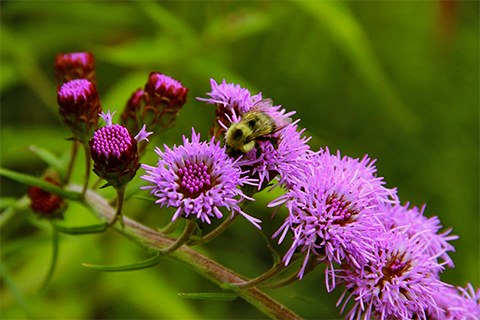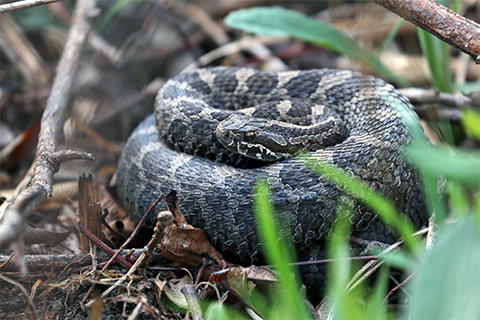Wildlife Watching at Jennings Environmental Education Center
Prairie Ecosystem

“Prairie” is a French word for meadow, which was used by early explorers to describe any open, grassy area. The forests experienced by early explorers were extremely dark and immense, making open areas rare and valuable.
Open areas provided an opportunity for pioneers to see the sun, rest and feed their animals. Today, we define prairies as distinct communities of plants and animals.
One particular flower that is abundant in the Jennings prairie is the magnificent blazing star. Normally associated with Midwestern prairies, its occurrence in Pennsylvania is unique because it is outside of its normal range.
These bright purple flowers clustering on 4- to 6-foot stalks create a spectacular show during peak bloom time in late July and early August. The late bloom time is common for prairie plants, which prefer the hot, dry weather of midsummer.

Wildflowers and grasses support a vast array of butterflies and moths, as well as other insects that serve as food for amphibians, birds and small mammals. The amphibians and small mammals, in turn, are food for a special prairie resident, the massasauga rattlesnake (above).
The Jennings prairie is one of the few places in the state where this snake is found. Due to the loss of its wet meadow habitat, the massasauga is endangered in Pennsylvania and is strictly protected. Like all rattlesnakes, the massasauga is venomous and may bite if surprised or threatened. Please stay on the trails for your own safety and the snake’s protection.
The Jennings Woodlands
Over three-quarters of the park is covered by forest. These woodlands include stream valleys, upland forests, and wetlands, which provide diverse habitats for wildlife. Stories from the past can be revealed by closely examining these forest communities.
The stream valley along Big Run was once filled with majestic American elms. Sadly, most of these trees have succumbed to Dutch elm disease, a fungus introduced to North America in the 1930s.
Other common bottomland trees stand where the elms once grew. Yellow birch and basswood are among the trees that prefer the rich, moist soils and cooler temperatures found in Big Run valley.
In spring, this valley is carpeted with delicate woodland wildflowers. Trillium, hepatica, spring beauties, and other flowers race to bloom before the tree canopy closes and blocks sunlight from the forest floor.
A gentle climb out of the valley leads to the drier, hardwood forest consisting primarily of oak, maple, hickory, and cherry. Early colonists realized the economic value of these hardwoods.
By 1820, Butler County’s timber was nearly gone. The size of the trees at Jennings today indicates the relatively young age of the forest.
Today, the forest is valued for more than economic reasons. By providing food, shelter, and cover, the Jennings woodlands are home to an abundance of wildlife, where visitors can enjoy solitude and experience the natural environment.
Natural Resources Management and Research
Managing and protecting the natural resources of the park are two of Jennings’ foremost goals.
The prairie, surrounding woodlands, streams, and wetlands have distinct management requirements. The uniqueness and diversity of these resources requires a holistic approach to management.
Prescribed Burn
A dramatic technique that benefits the prairie is the use of fire, which occurs naturally in many prairie ecosystems.
At Jennings, a controlled burn is used to slow the growth of woody plants and rejuvenate the native grasses and wildflowers.
American Columbo
The American columbo is an endangered plant species in Pennsylvania. Jennings has one of the few significant populations in the state. The life cycle of the columbo is unusual and not well understood.
This mysterious plant blooms once in its lifetime and then dies. Continuing research by staff is necessary to prevent the American columbo’s disappearance from Pennsylvania.
Past Problems, Future Solutions
Drainage from abandoned coal mines has a tremendous impact on Pennsylvania’s water quality. Coal seams exposed to air and water produce sulfuric acid and an orange precipitate known as yellow boy.
This abandoned mine drainage (AMD) flows into streams, causing pollution so severe that plant and animal life may not survive.
At Jennings, mine drainage flows into Big Run from a nearby abandoned mine. In cooperation with other agencies and private organizations, Jennings has explored several innovative, passive technologies to combat this pollution.
These technologies were initially modeled after wetlands, which act as natural filtering systems. The passive systems now in place provide a unique site for continued research, experimental management, and environmental education.
Numerous interpretive exhibits throughout the Jennings Abandoned Mine Drainage Treatment, Research and Demonstration Area provide information about the formation and treatment of AMD.